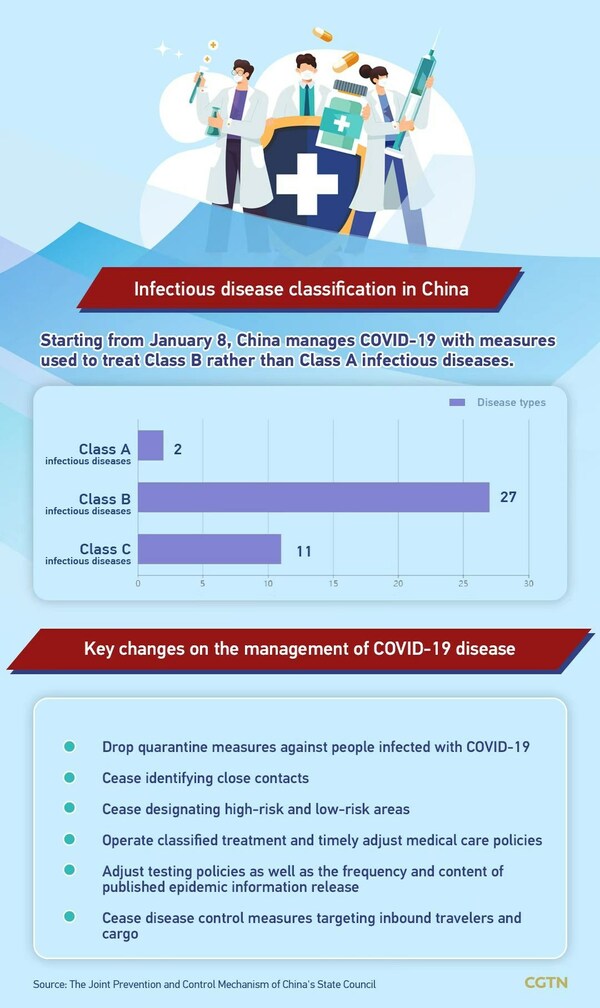BEIJING, Jan. 9, 2023 /PRNewswire/ -- China put its downgraded COVID-19 measures into force on Sunday as the nation began to resume normal life after three years of strict pandemic management.
The nation reopened its border ports for cargo transportation as well as inbound and outbound visitors. It also resumed services for Chinese citizens to apply for passports and visas for business and recreation.
Quarantine and on-site COVID-19 tests for the inbound visitors were scrapped, as well as preventative disinfection on imported goods and sampling inspection on cold-chain food.
The country will no longer enforce quarantine measures or mass COVID-19 tests. Practices of identifying close contacts or designating high- and low-risk areas have also discontinued.
Policy changes
China downgraded management of COVID-19 from Class A to Class B and removed it from quarantinable infectious disease management following an array of recent policy shifts regarding the virus, as the nation hit a full vaccination rate of over 90 percent and the COVID-19 virus exhibited less severity.
During the pandemic, COVID-19 was classified as a Class-B infectious disease but was subject to the preventive and control measures for a Class-A infectious disease in China, coming with stringent policies such as quarantine and frequent epidemiological surveys.
China has categorized 40 notifiable infectious diseases in three classes (Class A, Class B and Class C). Plague and cholera are listed as Class A infectious diseases. SARS, AIDS and tuberculosis are among the Class B infectious diseases. Class C infectious diseases include influenza and mumps.
An infectious disease is categorized based on a comprehensive assessment of multiple factors including pathogen characteristics, symptoms, how far and fast it can spread, how much it harms health, its social and economic influence, as well as group immunity and health system capability, according to Liang Wannian, head of the COVID-19 response expert panel under China's National Health Commission (NHC).
"At the outbreak of the pandemic, we categorized COVID-19 as a Class B disease but applied Class A management because of its rapid spread," said Liang, adding that they didn't know much about the disease at the beginning, and such management was needed to protect people.
Liang explained some key conditions have changed recently including the less deadly virus mutation, high vaccination rate and the country's growing epidemic response support, all of which built a great foundation to make new adjustments.
"We are ready to downgrade it to Class B management to respond to the infections in a more precise, scientific manner," said Liang.
The expert also stressed that the downgraded management doesn't mean the country has no control on or has stopped all preventative measures against the virus.
"It means we are stepping up our health services and epidemic response capability," said Liang.
China renamed the Chinese term for COVID-19 in December from "novel coronavirus pneumonia" to "novel coronavirus infection" to more accurately describe the disease.
Stepped-up COVID-19 response
The NHC released its 10th edition of the guidelines for COVID-19 infection prevention and control on Saturday, emphasizing the importance of boosting vaccination among high risk groups such as the elderly.
It reinforced monitoring and early warning capabilities, including regular monitoring on virus mutation, unknown pneumonia, urban wastewater, hospitals and extra steps in emergency such as monitoring among key groups.
Communities will no longer go through mass COVID-19 tests, which will be provided for those who require them.
"For now, medical treatment for severe cases is our priority," said Liang. He said further boosting vaccination, virus monitoring and suburb healthcare capability are of great importance.
"For any contagious disease like this, it's not enough to only depend on the government," Liang said, "it depends on the synergy coming from the government, society, all the organizations and each one of us."










